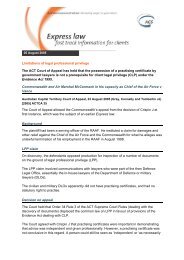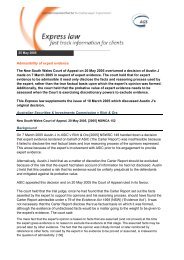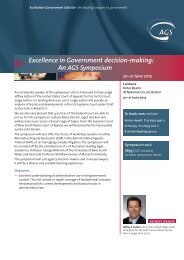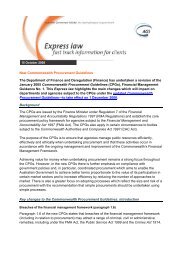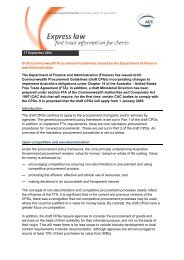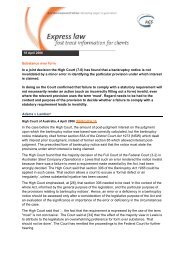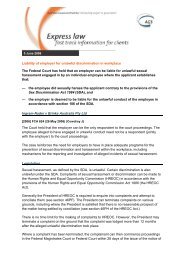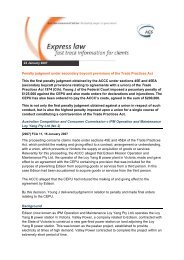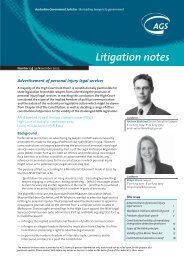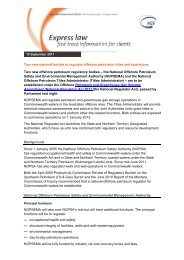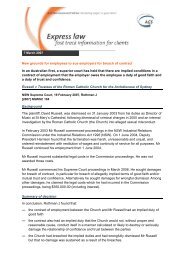annual report 2012 â 13 - Australian Government Solicitor
annual report 2012 â 13 - Australian Government Solicitor
annual report 2012 â 13 - Australian Government Solicitor
Create successful ePaper yourself
Turn your PDF publications into a flip-book with our unique Google optimized e-Paper software.
NOTES TO AND FORMING PART OF THE FINANCIAL STATEMENTSfor the year ended 30 June 20<strong>13</strong>classified as held-to-maturity investments. Held-tomaturityinvestments are recorded at amortised costusing the effective interest method less impairment,with revenue recognised on an effective yield basis.Loans and receivablesTrade receivables, loans and other receivables that havefixed or determinable payments that are not quoted inan active market are classified as ‘loans and receivables’.Loans and receivables are measured at amortised costusing the effective interest method less impairment.Interest is recognised by applying the effective interestrate.Impairment of financial assetsFinancial assets are assessed for impairment at the endof each <strong>report</strong>ing period.Financial assets held at amortised cost If there isobjective evidence that an impairment loss has beenincurred for loans and receivables or held to maturityinvestments held at amortised cost, the amount of theloss is measured as the difference between the asset’scarrying amount and the present value of estimatedfuture cash flows discounted at the asset’s originaleffective interest rate. The carrying amount is reducedby way of an allowance account. The loss is recognisedin the Statement of Comprehensive Income.1.<strong>13</strong> Financial LiabilitiesFinancial liabilities are classified as other financialliabilities.Financial liabilities are recognised and derecognisedupon trade date.Other financial liabilitiesOther financial liabilities, including borrowings, areinitially measured at fair value, net of transactioncosts. These liabilities are subsequently measured atamortised cost using the effective interest method, withinterest expense recognised on an effective yield basis.Other financial liabilities are subsequently measured atamortised cost using the effective interest method, withinterest expense recognised on an effective yield basis.The effective interest method is a method of calculatingthe amortised cost of a financial liability and ofallocating interest expense over the relevant period. Theeffective interest rate is the rate that exactly discountsestimated future cash payments through the expectedlife of the financial liability, or, where appropriate, ashorter period.Supplier and other payables are recognised at amortisedcost. Liabilities are recognised to the extent that thegoods or services have been received (and irrespective ofhaving been invoiced).1.14 Contingent liabilities and contingent assetsContingent Liabilities and Contingent Assets are notrecognised in the Balance Sheet but are <strong>report</strong>ed inthe relevant schedules and notes. They may arise fromuncertainty as to the existence of a liability or asset orrepresent an asset or liability in respect of which theamount cannot be reliably measured. Contingent assetsare disclosed when settlement is probable but notvirtually certain and contingent liabilities are disclosedwhen settlement is greater than remote.1.15 Acquisition of assetsAssets are recorded at cost on acquisition except as statedbelow. The cost of acquisition includes the fair value ofassets transferred in exchange and liabilities undertaken.Financial assets are initially measured at their fair valueplus transaction costs where appropriate.Assets acquired at no cost, or for nominal consideration,are initially recognised as assets and income at their fairvalue at the date of acquisition.1.16 Infrastructure, plant and equipmentAsset recognition thresholdPurchases of infrastructure, plant and equipment arerecognised initially at cost in the Balance Sheet, wherethe equipment has a useful economic life greater than12 months and the type of asset collectively represents asignificant investment of AGS funds. Other purchases areexpensed in the year of acquisition.The initial cost of an asset includes an estimate of thecost of dismantling and removing the item and restoringthe site on which it is located. This is particularly relevantto ‘makegood’ provisions in property leases taken upby AGS where there exists an obligation to restore theproperty to its original condition. These costs are includedin the value of AGS leasehold improvements with acorresponding provision for the ‘makegood’ taken up.RevaluationsFair values for each class of assets are determined asshown below.Asset classLibraryLeasehold improvementsInfrastructure, plant andequipmentFair value measured at:Market selling priceDepreciated replacement costMarket selling priceFollowing initial recognition at cost, property, plant andequipment are carried at fair value less subsequentaccumulated depreciation and accumulated impairmentlosses. Valuations are conducted with sufficient frequencyto ensure that the carrying amounts of assets do notmaterially differ with the assets’ fair values as at the<strong>report</strong>ing date. The regularity of independent valuationsdepends upon the volatility of movements in marketvalues for the relevant assets.Revaluation adjustments are made on an asset by assetbasis as AGS is a for-profit entity.Any revaluation increment is credited to equity under theheading of asset revaluation reserve except to the extentthat it reverses a previous revaluation decrement of the68 AGS Annual <strong>report</strong> <strong>2012</strong>–<strong>13</strong>



